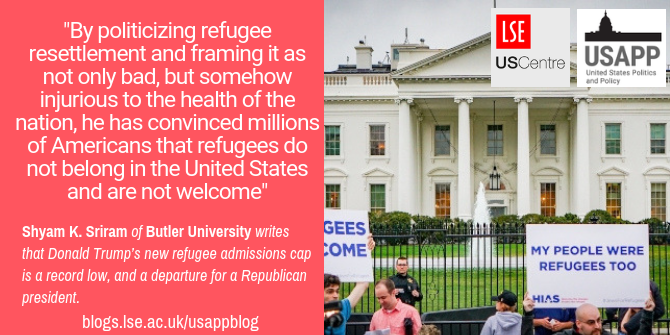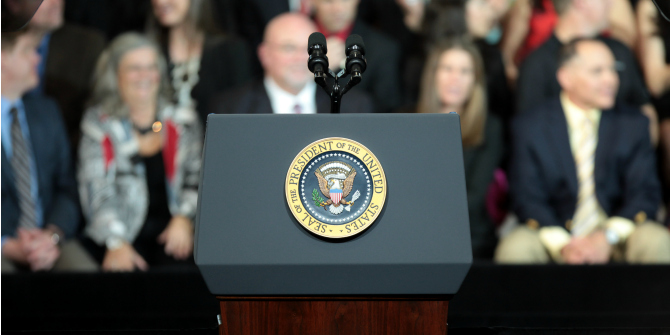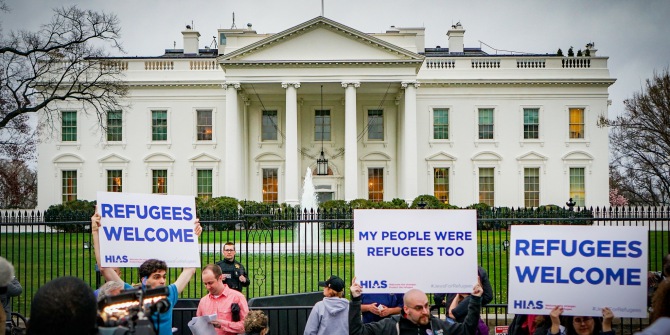 President Trump recently announced a dramatic fall in the cap for US refugee admissions. Shyam K. Sriram puts this policy change in context, commenting that while since 1980, the ceiling for refugee admissions has varied, it fell below 50,000 for the first time in 2018. Refugee admissions, he finds, have never been as low as they are now under President Trump.
President Trump recently announced a dramatic fall in the cap for US refugee admissions. Shyam K. Sriram puts this policy change in context, commenting that while since 1980, the ceiling for refugee admissions has varied, it fell below 50,000 for the first time in 2018. Refugee admissions, he finds, have never been as low as they are now under President Trump.
Last week, President Trump set the cap for the number of refugees to be admitted into the US in the next year at 18,000 – its lowest ever number, and less than 1/5th the number admitted under President Obama. Refugee resettlement is a function of government that relies on an elaborate pastiche of power-sharing between the federal, state, and local governments, as well as private refugee resettlement organizations (RROs). It has always been political, and historically the result of two competing sets of political interests: immigration restrictionism and immigration expansionism. Since the United States Department of State began officially keeping track of admissions in 1975, a little over 3.4 million refugees have been accepted into the United States. In that time, eight presidents have overseen the refugee resettlement program, and instituted changes to the refugee limit or ceiling based on infrastructural demands, public opinion, and national and international tragedies.
Until 1980, the United States’ policy was primarily to grant refugee status to people trying to escape Communism and Communist governments. With the passage of the Refugee Act in 1980 by Congress and President Jimmy Carter, the US officially changed its criteria to be more in line with the United Nations’ definition, and create a clearer and organized system to outline how resettlement was to take place.
One of the key provisions of the 1980 Refugee Act is the allowance for an annual ceiling of 50,000 refugees allowed to come to the United States ever year. The statute allows for changes in that number, but the expectation was that if a president wanted to exceed it, (s)he could do so with congressional approval. But what happens when a president wants to lower the refugee ceiling? The Trump administration did just that in 2018 and again in 2019. As this recent report from the Congressional Research Service (CRS) indicates, the refugee admissions ceiling jumped from 85,000 in 2016 to 110,000 in 2017, only to fall to 45,000 in 2018 and 30,000 in 2019. This is the first time since 1975 that the refugee admissions ceiling has been set lower than 50,000. Of even greater consequence is that only about 22,500 refugees were admitted in 2018 and as of August 31st of this year, that number is just over 28,000.
Using data from 1975 to 2019 from the State Department’s Worldwide Refugee Admissions Processing System (WRAPS), I wanted to understand how Trump compared to previous presidents in terms of the total number of refugees allowed each year. The results are staggering. Figure 1 illustrates my findings. Refugee admissions were exceptionally high around 1975 and the Fall of Saigon; in that fiscal year alone, the United States received more than 146,000 refugees. By 1977, the first year of the Carter presidency, only just under 20,000 refugees were admitted, primarily the result of public opposition to what was perceived as too great numbers accepted for resettlement. With the passage of the 1980 Refugee Act by Carter, there was a ten-fold increase in the number of refugees accepted by the United States. The robust pace continued during the Reagan administration with a dip in the early ‘80s due to public perceptions of Cuban refugees.
Figure 1 – US Refugee Admissions: 1975 to 2019

The rate increased again during the presidency of George H.W. Bush and by 1992 had reached 132,500 per year – the highest in over a decade. This pace maintained itself during the Clinton administration, but dropped substantially following 9/11, and would only reach pre-9/11 levels by the end of Obama’s second term in 2016. Within two years, refugee admissions would drop from 85,000 in 2016 to 53,700 in 2017 and 14,300 as of June 2018 – an 83 percent decline. Except for the post-Carter anomaly, refugee admissions have never been as low as they are now under President Trump.

“2017.03.01 #JewsForRefugees Rally, Washington, DC USA 01318” by Ted Eytan is licensed under CC BY SA 2.0
Figure 2 indicates the total number of refugees admitted by president. Here again, we see the makings of two narratives not often discussed publicly or by the media. First, more refugees were accepted and resettled in the United States under Republican presidents (1,794,500) versus Democrats (1,647,500). Second, Trump is an anomaly among Republicans; while his administration has been the least receptive towards refugees, that is clearly not the case for Ford, Reagan, HW Bush, or “Dubya” who accepted on average 86,700; 82,500; 118,800; and 47,700 refugees per year during their terms in office.
Figure 2 – Mean number of refugees admitted per year across entire presidential term

It has been almost 1,000 days since President Trump’s inauguration. Within days of taking office in January 2017, he signed Executive Order 13769 suspending the US Refugee Admissions Program for 120 days, Syrian refugee resettlement, and all immigration from seven countries. This caused the resettlement community, public and private, to implode – a calculated policy change, according to Deborah Amos. The president’s actions have also caused global shifts by denying sanctuary in the United States and de-emphasizing four decades of humanitarian policy. When the United States provides 40 percent of the budget of the United Nations High Commissioner for Refugees and then balks at paying its share, you have the ingredients for a global crisis. The New York Times reported recently that the president wants to drop the refugee ceiling to 15,000 people while other people in the administration have commented that Trump may even eliminate the entire program.
President Trump has manufactured a political crisis with the most extreme and negative consequences. By politicizing refugee resettlement and framing it as not only bad, but somehow injurious to the health of the nation, he has convinced millions of Americans that refugees do not belong in the United States and are not welcome. As Suketu Mehta curtly put it, “The west is being destroyed, not by migrants, but by the fear of migrants … In country after country, the ghosts of fascists have rematerialized … they have successfully convinced their populations that the greatest threat to their nations isn’t government tyranny or inequality or climate change, but immigration.” We never saw the refugee resettlement program as a threat to American life. Until now.
Please read our comments policy before commenting.
Note: This article gives the views of the author, and not the position of USAPP – American Politics and Policy, nor the London School of Economics.
Shortened URL for this post: http://bit.ly/2mQPVLd
About the author
 Shyam K. Sriram – Butler University
Shyam K. Sriram – Butler University
Shyam K. Sriram is a visiting assistant professor of political science at Butler University. He has published in South Asian Diaspora, the Asian Journal of Comparative Politics, the Kansas Journal of Law & Public Policy, the International Journal of Islamic Thought, and the eJournal of Public Affairs. This article is adapted from his 2018 dissertation from the University of California at Santa Barbara: “The Politics of Refugee Resettlement.”






